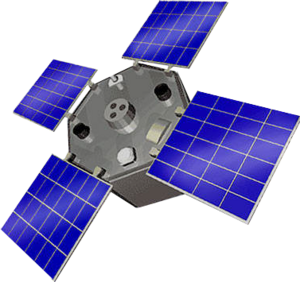 ACRIMSAT satellite | |
| Names | Active Cavity Radiometer Irradiance Monitor Satellite |
|---|---|
| Mission type | Solar astronomy |
| Operator | NASA / JPL |
| COSPAR ID | 1999-070B |
| SATCAT no. | 26033 |
| Website | acrim |
| Mission duration | 5 years (planned) 13 years, 11 months and 23 days (achieved) [1] |
| Spacecraft properties | |
| Manufacturer | Orbital Sciences Corporation |
| Launch mass | 115 kg (254 lb) |
| Dimensions | 77.5 cm (30.5 in) wide 66 cm (26 in) high Total span with solar arrays 178 cm (70 in) |
| Power | 80 watts |
| Start of mission | |
| Launch date | 21 December 1999, 07:13 UTC |
| Rocket | Taurus 2110 |
| Launch site | Vandenberg, LC-576E |
| Contractor | Orbital Sciences Corporation |
| Entered service | April 2000 |
| End of mission | |
| Deactivated | 30 July 2014 |
| Last contact | 14 December 2013 |
| Orbital parameters | |
| Reference system | Geocentric orbit[2] |
| Regime | Sun-synchronous orbit |
| Perigee altitude | 683 km (424 mi) |
| Apogee altitude | 727 km (452 mi) |
| Inclination | 98.30° |
| Period | 99.00 minutes |
| Instruments | |
| Active Cavity Radiometer Irradiance Monitor-3 (ACRIM-3) | |
The Active Cavity Radiometer Irradiance Monitor Satellite, or ACRIMSAT was a satellite carrying the ACRIM-3 (Active Cavity Radiometer Irradiance Monitor 3) instrument. It was one of the 21 observational components of NASA's Earth Observing System program. The instrument followed upon the ACRIM-1 and ACRIM-2 instruments that were launched on multi-instrument satellite platforms. ACRIMSAT was launched on 20 December 1999 from Vandenberg Air Force Base as the secondary payload on the Taurus launch vehicle that launched KOMPSAT. It was placed into a high inclination of 98.30°, at 720 km. Sun-synchronous orbit from which the ACRIM-3 instrument monitored total solar irradiance (TSI).[3] Contact with the satellite was lost on 14 December 2013.[4]
- ^ "ACRIMSAT". Gunter's Space Page. 20 September 2018. Retrieved 29 October 2021.
- ^ "ACRIMSAT 1999-070B 26033". NASA. 28 October 2021. Retrieved 29 October 2021.
 This article incorporates text from this source, which is in the public domain.
This article incorporates text from this source, which is in the public domain.
- ^ "ACRIM TSI time series". acrim.com. Archived from the original on 16 July 2011. Retrieved 29 October 2021.
- ^ "Sun sets for a NASA solar monitoring spacecraft". NASA Jet Propulsion Laboratory. 8 August 2014. Retrieved 29 October 2021.
 This article incorporates text from this source, which is in the public domain.
This article incorporates text from this source, which is in the public domain.